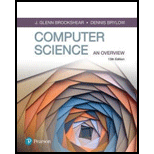
Pearson eText for Computer Science: An Overview -- Instant Access (Pearson+)
13th Edition
ISBN: 9780137503216
Author: Glenn Brookshear, Dennis Brylow
Publisher: PEARSON+
expand_more
expand_more
format_list_bulleted
Concept explainers
Expert Solution & Answer
Chapter 9, Problem 49CRP
Explanation of Solution
Determine the time taken to retrieve a record from the middle of the file:
The total number of records in a file is 50,000 and the time required to interrogate an entry is 5 milliseconds.
- To find the record from the middle of the line, divide 50,000 records by 2 as given below:
- Thus, the number of records from the middle of a line is 25,000.
- To find the time taken to retrieve a record from the middle of a line, multiply 25,000 records by 5 milliseconds as given below:
Expert Solution & Answer
Want to see the full answer?
Check out a sample textbook solution
Students have asked these similar questions
What is the difference between sequential and random file organisation ?
In data structures and algorithms,which operations combine record into different sorted files into a single sorted file?
Distinguish between the two basic types of record-access methods: sequential and random.
Chapter 9 Solutions
Pearson eText for Computer Science: An Overview -- Instant Access (Pearson+)
Ch. 9.1 - Identify two departments in a manufacturing plant...Ch. 9.1 - Prob. 2QECh. 9.1 - Summarize the roles of the application software...Ch. 9.2 - Prob. 1QECh. 9.2 - Prob. 2QECh. 9.2 - Prob. 4QECh. 9.2 - Prob. 5QECh. 9.2 - Prob. 6QECh. 9.3 - Prob. 1QECh. 9.3 - What is a persistent object?
Ch. 9.3 - Identify some classes as well as some of their...Ch. 9.3 - Prob. 4QECh. 9.4 - Prob. 1QECh. 9.4 - Prob. 2QECh. 9.4 - Prob. 3QECh. 9.4 - Prob. 4QECh. 9.4 - Prob. 5QECh. 9.4 - Prob. 6QECh. 9.5 - Prob. 1QECh. 9.5 - Prob. 2QECh. 9.5 - Prob. 3QECh. 9.5 - Prob. 4QECh. 9.5 - Prob. 5QECh. 9.5 - Prob. 6QECh. 9.5 - Prob. 7QECh. 9.6 - Prob. 1QECh. 9.6 - Give an additional example of a pattern that might...Ch. 9.6 - Prob. 3QECh. 9.6 - How does data mining differ from traditional...Ch. 9.7 - Prob. 1QECh. 9.7 - Prob. 2QECh. 9.7 - Prob. 3QECh. 9.7 - Prob. 4QECh. 9 - Prob. 1CRPCh. 9 - Prob. 2CRPCh. 9 - Prob. 3CRPCh. 9 - Prob. 4CRPCh. 9 - Prob. 5CRPCh. 9 - Prob. 6CRPCh. 9 - Prob. 7CRPCh. 9 - Prob. 8CRPCh. 9 - Prob. 9CRPCh. 9 - Prob. 10CRPCh. 9 - Prob. 11CRPCh. 9 - Prob. 12CRPCh. 9 - Using the commands SELECT, PROJECT, and JOIN,...Ch. 9 - Answer Problem 13 using SQL. PROBLEM 13 13. Using...Ch. 9 - Prob. 15CRPCh. 9 - Prob. 16CRPCh. 9 - Prob. 17CRPCh. 9 - Prob. 18CRPCh. 9 - Prob. 19CRPCh. 9 - Empl Id Name Address SSN Job Id Job Title Skill...Ch. 9 - Empl Id Name Address SSN Job Id Job Title Skill...Ch. 9 - Prob. 22CRPCh. 9 - Prob. 23CRPCh. 9 - Prob. 24CRPCh. 9 - Prob. 25CRPCh. 9 - Write a sequence of instructions (using the...Ch. 9 - Prob. 27CRPCh. 9 - Prob. 28CRPCh. 9 - Prob. 29CRPCh. 9 - Prob. 30CRPCh. 9 - Prob. 31CRPCh. 9 - Prob. 32CRPCh. 9 - Prob. 33CRPCh. 9 - Prob. 34CRPCh. 9 - Prob. 35CRPCh. 9 - Prob. 36CRPCh. 9 - Prob. 37CRPCh. 9 - Prob. 38CRPCh. 9 - Prob. 39CRPCh. 9 - Prob. 40CRPCh. 9 - Prob. 41CRPCh. 9 - Prob. 42CRPCh. 9 - Prob. 43CRPCh. 9 - Prob. 44CRPCh. 9 - Prob. 45CRPCh. 9 - Prob. 46CRPCh. 9 - Prob. 47CRPCh. 9 - Prob. 48CRPCh. 9 - Prob. 49CRPCh. 9 - Prob. 50CRPCh. 9 - Prob. 51CRPCh. 9 - Prob. 52CRPCh. 9 - Prob. 53CRPCh. 9 - Prob. 54CRPCh. 9 - Prob. 55CRPCh. 9 - Prob. 56CRPCh. 9 - Prob. 57CRPCh. 9 - Prob. 58CRPCh. 9 - Prob. 59CRPCh. 9 - Prob. 60CRPCh. 9 - Prob. 61CRPCh. 9 - Prob. 62CRPCh. 9 - Prob. 1SICh. 9 - Prob. 2SICh. 9 - Prob. 3SICh. 9 - Prob. 4SICh. 9 - Prob. 5SICh. 9 - Prob. 6SICh. 9 - Prob. 7SICh. 9 - Prob. 8SICh. 9 - Prob. 9SICh. 9 - Prob. 10SI
Knowledge Booster
Learn more about
Need a deep-dive on the concept behind this application? Look no further. Learn more about this topic, computer-science and related others by exploring similar questions and additional content below.Similar questions
- Is it possible for files to become clustered after they have been filled with records?arrow_forwardSuppose a file with 65536 records is organized using multi-level indexing as the file is ordered on a non-key field. Each record is 48 bytes long and the size of its key field is 4 bytes. The indexing is built on the key field of the file. The size of the disk block is 2 KB, and the block pointer size is 12 bytes. The file organization is unspanned. How many blocks will be required for the inner and outer index respectively in a multi-level index? 512 and 2 b) 512 and 4 e) 1024 and 4 d) 1024 and 8arrow_forwardWhat are a few problems with conventional file processing?arrow_forward
- Given the following data file: STUDENT(ID, SNAME, ADDRESS, LEVEL, GPA, …) Suppose that: record size R = 200 bytes block size B = 512 bytes r = 2000 records Then, Find out: Blocking factor(Bfr) Bfr=B/R Number of file blocks(b) b=r/bfrarrow_forwardThe term Field in a file is defined as ...... O O O logical part of a file that holds a related set of data information that written in order from the beginning to the end part of a record which defines a specific informationarrow_forwardHow do "file signatures" and "magic numbers" assist in identifying file types and formats, and how are they employed in software applications?arrow_forward
arrow_back_ios
SEE MORE QUESTIONS
arrow_forward_ios
Recommended textbooks for you
 Systems ArchitectureComputer ScienceISBN:9781305080195Author:Stephen D. BurdPublisher:Cengage Learning
Systems ArchitectureComputer ScienceISBN:9781305080195Author:Stephen D. BurdPublisher:Cengage Learning

Systems Architecture
Computer Science
ISBN:9781305080195
Author:Stephen D. Burd
Publisher:Cengage Learning